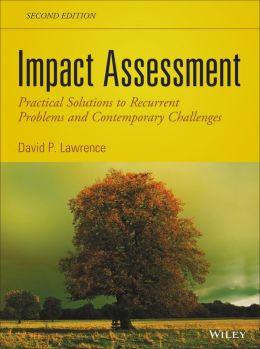 [内容简介]
[内容简介]
Offers solutions and best practices to respond to recurrent problems and contemporary challenges in the field
Since the publication of the first edition of Environmental Impact Assessment in 2003, both the practice and theory of impact assessment have changed substantially. Not only has the field been subject to a great deal of new regulations and guidelines, it has also evolved tremendously, with a greater emphasis on strategic environmental, sustainability, and human health impact assessments. Moreover, there is a greater call for impact assessments from a global perspective. This Second Edition, now titled Impact Assessment to reflect its broader scope and the breadth of these many changes, offers students and practitioners a current guide to today's impact assessment practice.
Impact Assessment begins with an introduction and then a chapter reviewing conventional approaches to the field. Next, the book is organized around recurrent problems and contemporary challenges in impact assessment process design and management, enabling readers to quickly find the material they need to solve tough problems, including:
- How to make impact assessments more influential, rigorous, rational, substantive, practical, democratic, collaborative, ethical, and adaptive
- How each problem and challenge-reducing process would operate at the regulatory and applied levels
- How each problem can be approached for different impact assessment types—sustainability assessment, strategic environmental assessment, project-level EIA, social impact assessment, ecological impact assessment, and health impact assessment
- How to link and combine impact assessment processes to operate in situations with multiple overlapping problems, challenges, and impact assessment types
- How to connect and combine impact assessment processes
Each chapter first addresses the topic with current theory and then demonstrates how that theory is applied, presenting requirements, guidelines, and best practices. Summaries at the end of each chapter provide a handy tool for structuring the design and evaluation of impact assessment processes and documents. Readers will find analyses and new case studies that address such issues as multi-jurisdictional impact assessment, climate change, cumulative effects assessment, follow-up, capacity building, interpreting significance, and the siting of major industrial and waste facilities.
Reflecting current theory and standards of practice, Impact Assessment is appropriate for both students and practitioners in the field, enabling them to confidently respond to a myriad of new challenges in the field.
[目录]
Preface ix
1. Introduction 1
1.1 Highlights 1
1.2 A “Not So Hypothetical” Scenario 1
1.3 The Basics 5
1.4 A Structure 12
1.5 A Strategy 16
1.6 A Road Map 19
1.7 Summing Up 20
2. Conventional IA Processes 22
2.1 Highlights 22
2.2 Defining the Problem and Deciding on a Direction 22
2.3 Conventional EIA Choices 23
2.4 Choices for Other IATypes 34
2.5 Contemporary Challenge—SEA Good Practice Guidance 46
2.6 Summing Up 49
3. How to Make IAs More Influential 52
3.1 Highlights 52
3.2 Insights from Practice 52
3.3 Defining the Problem and Deciding on a Direction 56
3.4 Selecting the Most Appropriate Route 62
3.5 Instituting an Influential IA Process 75
3.6 Contemporary Challenge—IA Influence—Good Practice Guidance 84
3.7 Summing Up 84
4. How to Make IAs More Rigorous 91
4.1 Highlights 91
4.2 Insights from Practice 91
4.3 Defining the Problem and Deciding on a Direction 94
4.4 Selecting the Most Appropriate Route 94
4.5 Instituting a Rigorous IA Process 100
4.6 Contemporary Challenge—Good Practice IA Follow-up 111
4.7 Summing Up 114
5. How to Make IAs More Rational 116
5.1 Highlights 116
5.2 Insights from Practice 116
5.3 Defining the Problem and Deciding on a Direction 119
5.4 Selecting the Most Appropriate Route 121
5.5 Instituting a Rational IA Process 129
5.6 Contemporary Challenge—Siting “Locally Unwanted Land Uses” 139
5.7 Summing Up 148
6. How to Make IAs More Substantive 150
6.1 Highlights 150
6.2 Insights from Practice 150
6.3 Defining the Problem and Deciding on a Direction 153
6.4 Selecting the Most Appropriate Route 156
6.5 Instituting a Substantive IA Process 169
6.6 Contemporary Challenge—Horizontal IA Integration 179
6.7 Summing Up 183
7. How to Make IAs More Practical 186
7.1 Highlights 186
7.2 Insights from Practice 186
7.3 Defining the Problem and Deciding on a Direction 190
7.4 Selecting the Most Appropriate Route 194
7.5 Instituting a Practical IA Process 213
7.6 Contempory Challenge—CEA Good Practice 222
7.7 Summing Up 225
8. How to Make IAs More Democratic 227
8.1 Highlights 227
8.2 Insights from Practice 227
8.3 Defining the Problem and Deciding on a Direction 230
8.4 Selecting the Most Appropriate Route 233
8.5 Instituting a Democratic IA Process 244
8.6 Contemporary Challenge—Multijurisdictional IA 252
8.7 Summing Up 258
9. How to Make IAs More Collaborative 261
9.1 Highlights 261
9.2 Insights from Practice 261
9.3 Defining the Problem and Deciding on a Direction 264
9.4 Selecting the Most Appropriate Route 269
9.5 Instituting a Collaborative IA Process 299
9.6 Contemporary Challenge—IA Capacity Building 308
9.7 Summing Up 312
10. How to Make IAs More Ethical 315
10.1 Highlights 315
10.2 Insights from Practice 315
10.3 Defining the Problem and Deciding on a Direction 318
10.4 Selecting the Most Appropriate Route 319
10.5 Instituting an Ethical IA Process 330
10.6 Contemporary Challenge—Significance Determination 337
10.7 Summing Up 344
11. How to Make IAs More Adaptable 346
11.1 Highlights 346
11.2 Insights from Practice 346
11.3 Defining the Problem and Deciding on a Direction 349
11.4 Selecting the Most Appropriate Route 352
11.5 Instituting an Adaptive IA Process 383
11.6 Contemporary Challenge—Climate Change 391
11.7 Summing Up 392
12. How to Connect and Combine IA Processes 399
12.1 Highlights 399
12.2 Insights from Practice 399
12.3 Defining the Problem and Deciding on a Direction 404
12.4 Composite Regulatory Frameworks 405
12.5 Recurrent Problems 406
12.6 IATypes 415
12.7 Contemporary Challenge—Matching Process and Context 418
12.8 Contemporary Challenges 423
12.9 Composite IA Processes 423
12.10 Limits and Priorities 431
12.11 Summing Up 433
References 435
Index 469

 新书报道
新书报道